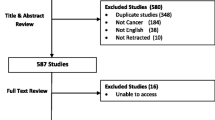Abstract
Since the solution to many public health problems depends on research, it is critical for the progress and well-being for the patients that we can trust the scientific literature. Misconduct and poor laboratory practice in science threatens the scientific progress, leads to loss of productivity and increased healthcare costs, and endangers lives of patients. Data duplication may represent one of challenges related to these problems. In order to estimate the frequency of data duplication in life science literature, a systematic screen through 120 original scientific articles published in three different cancer related journals [journal impact factor (IF) <5, 5–10 and >20] was completed. The study revealed a surprisingly high proportion of articles containing data duplication. For the IF < 5 and IF > 20 journals, 25 % of the articles were found to contain data duplications. The IF 5–10 journal showed a comparable proportion (22.5 %). The proportion of articles containing duplicated data was comparable between the three journals and no significant correlation to journal IF was found. The editorial offices representing the journals included in this study and the individual authors of the detected articles were contacted to clarify the individual cases. The editorial offices did not reply and only 1 out of 29 cases were apparently clarified by the authors, although no supporting data was supplied. This study questions the reliability of life science literature, it illustrates that data duplications are widespread and independent of journal impact factor and call for a reform of the current peer review and retraction process of scientific publishing.

Similar content being viewed by others
References
Abbott, A. (2013). Image search triggers Italian police probe. News in focus. Nature, 504(7478), 18.
Avery, S. (2011). Flawed research appalls cancer patient. News & Observer. http://www.newsobserver.com/2011/01/09/908283/flawed-research-appalls-cancer.html.
Begley, C. G., & Ellis, L. M. (2012). Drug development: Raise standards for preclinical cancer research. Nature, 483(7391), 531–533.
Cokol, M., Lossifov, I., Rodriguez-Esteban, R., & Rzhetsky, A. (2007). How many scientific papers should be retracted? EMBO Reports, 8(5), 422–423.
Couzin-Frankel, J. (2013). Shaking up science. Science, 339(6118), 386–389.
Fanelli, D. (2009). How many scientists fabricate and falsify research? A systematic review and meta-analysis of survey data. PLoS One. doi:10.1371/journal.pone.0005738.
Fanelli, D. (2013). Why growing retractions are (mostly) a good sign. PLoS Medicine. doi:10.1371/journal.pmed.1001563.
Fang, F. C., & Casadevall, A. (2011). Retracted science and the retraction index. Infection and Immunology, 79(10), 3855–3859.
Fang, F. C., Steen, R. G., & Casadevall, A. (2012). Misconduct accounts for the majority of retracted scientific publications. Proceedings of the National Academy of Science USA, 109(42), 17028–17033.
Grieneisen, M. L., & Zhang, M. (2012). A comprehensive survey of retracted articles from the scholarly literature. PLoS One. doi:10.1371/journal.pone.0044118.
Liu, S. V. (2006). Top journals’ top retraction rates. Scientific Ethics, 1, 91–93.
Prinz, F., Schlange, T., & Asadullah, K. (2011). Believe it or not: how much can we rely on published data on potential drug targets? Nature Reviews Drug Discovery, 10(9), 712.
Rossner, M. (2006). How to guard against image fraud. The Scientist. http://www.the-scientist.com/?articles.view/articleNo/23749/title/How-to-Guard-Against-Image-Fraud/.
Rossner, M., & Yamada, K. M. (2004). What’s in a picture? The temptation of image manipulation. Journal of Cell Biology, 166(1), 11–15.
Steen, R. G. (2011a). Retractions in the scientific literature: is the incidence of research fraud increasing? Journal of Medical Ethics, 37(4), 249–253.
Steen, R. G. (2011b). Retractions in the medical literature: how many patients are put at risk by flawed research? Journal of Medical Ethics, 37(11), 688–692.
Sudbø, J., Kildal, W., Risberg, B., Koppang, H. S., Danielsen, H. E., & Reith, A. (2001). DNA content as a prognostic marker in patients with oral leukoplakia. New England Journal of Medicine, 344(17), 1270–1278 (Retraction in: Curfman, G.D., Morrissey, S., & Drazen, J.M. (2006). New England Journal of Medicine, 355(18), 1927).
Sudbø, J., Lee, J. J., Lippman, S. M., Mork, J., Sagen, S., Flatner, N., Ristimäki, A., Sudbø, A., Mao, L., Zhou, X., Kildal, W., Evensen, J. F., Reith, A., & Dannenberg, A. J. (2005). Non-steroidal anti-inflammatory drugs and the risk of oral cancer: a nested case-control study. Lancet, 366(9494), 1359–1366 (Retraction in: Horton, R. (2006). Lancet, 367(9508), 382).
Swartz, A. (2013, October 22). Post publication peer review mainstreamed. News & Opinion. The Scientist.
Van Noorden, R. (2011). Science publishing: The trouble with retractions. Nature, 478(7367), 26–28.
Acknowledgments
I thank Øistein Ihle for help with the article screening process and the text, and Angelina Hansen, Henrik S. Huitfeldt and Lise K. Bollum for discussions and critical reading of the manuscript.
Author information
Authors and Affiliations
Corresponding author
Rights and permissions
About this article
Cite this article
Oksvold, M.P. Incidence of Data Duplications in a Randomly Selected Pool of Life Science Publications. Sci Eng Ethics 22, 487–496 (2016). https://doi.org/10.1007/s11948-015-9668-7
Received:
Accepted:
Published:
Issue Date:
DOI: https://doi.org/10.1007/s11948-015-9668-7




